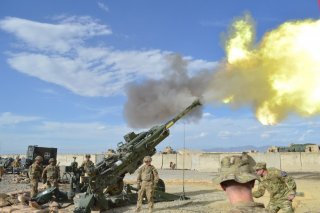U.S. Army Acquisitions Programs Are Critically Short on Time
The most precious resource the Army may be short of is time.
Of all the services, the U.S. Army faces the greatest number of challenges going forward. It is still bound up in two difficult local conflicts in Iraq and Afghanistan while continuing to downsize to an uncertain final end-strength. Units and equipment coming out of more than a decade of war must be retrained and refurbished. Efforts are ongoing to improve the integration of the Active and Reserve Components based on the recommendations of the recently completed National Commission on the Future of the Army. Several of the Commission’s recommendations will cost the Army billions in unplanned expenditures. After a series of rather spectacular acquisition failures, the Army needs to invest across the board in future capabilities for different and more dangerous adversaries. All of these challenges cost money, something which is in particularly short supply for the Army.
But the most precious resource the Army may be short of is time. Everyone has heard the expression ‘time is money.’ It is at the heart of the modern global economic system with its emphasis on just-in-time delivery. It is also abundantly true when it comes to defense acquisition. Defer maintenance and a platform may suffer a catastrophic failure, possibly grounding an entire fleet of vehicles or planes. Delay an acquisition program or shift procurement to the right and the cost of end-items increases. Conversely, shorten procurement timelines by permitting early acquisition of long-lead items for major platforms or agreeing to multi-year procurement of a major system and significant savings can be achieved.
Time is much more valuable than merely its ability to be manipulated in order to save money. It can also save lives. The Army learned the value of time in Iraq and Afghanistan when troops in combat were generating torrents of urgent operational needs to which the traditional acquisition system was unable to respond. As a result, the Pentagon created several special organizations, most notably the Joint IED Defeat Organization and the Rapid Equipping Force. The central focus of these efforts was on time, providing a partial solution to a given problem with 90 or at most 180 days. In order to achieve these exacting timelines both organizations were liberated from many of the oversight and reporting requirements imposed on the regular acquisition system, as well as the need to segregate their budget expenditures by the “color” of the money.
The Department of Defense, in general, and the Army, most particularly, is running out of time. The Army’s Operating Concept identifies five characteristics of the future operating environment, the first of which is the increased momentum of human interactions and events. Threats are appearing more rapidly, advanced weapons systems proliferating more swiftly and new zones of conflict opening up at an accelerated rate. Three years ago no one had even heard of ISIS. In 2008, Russia almost lost its fight with Georgia; in 2014 the Kremlin overran Crimea and destabilized eastern Ukraine. Almost overnight China turned a bunch of rocks and shoals in the South China Sea into military bases bristling with armament.
More significantly, all of this country’s prospective adversaries are engaged in major military modernization campaigns. Russia completely revamped its conventional force structure after the Georgian campaign; it now plans to have 70% of its armed forces modernized by 2020. The Russian Army has demonstrated a heretofore unrecognized ability to deploy rapidly and employ effectively combined arms forces supported by electronic warfare systems, targeting drones and advanced long-range fires. Beijing is reorganizing and streamlining its conventional forces to make them more capable in high-end conflicts. It is testing also advanced weapons systems such as a stealth fighter and a long-range, ship-killing ballistic missile. Russia, China, Iran and North Korea are all investing in programs to improve and expand their inventories of ballistic and even cruise missiles.
The U.S. Army is in the most problematic state given that it has experienced two lost decades of modernization. Yet, most of its requirements development and R&D activities appear based on the assumption that it has plenty of time to acquire new capabilities. The Army can least afford to take years and decades to produce the next generation of combat vehicles, aircraft and weapons systems. For example, does the Army really believe that it can wait until 2030 to begin low rate initial production of aircraft developed under the Future Vertical Lift program?
The Army leadership needs to make time a key parameter for every acquisition program. This means focusing on acquiring near-term capabilities that provide a degree of improvement vice waiting years for the “perfect” solution. The JIEDDO and REF model is to get something useful into the field now and work on improving it later. Whether it is active protection, secure communications, anti-drone defenses or electronic warfare, something now is going to be worth a lot in terms of capability and lives if there is a conflict. Focusing on shorter R&D and procurement timelines is also likely to save the Army money.
Army acquisition is in danger of drowning in its 260 identified capability gaps. The service’s leadership needs to bring order to this chaos, pare down this set of gaps to a handful of those that will make a real difference in land combat in the near-term and field workable, not perfect, solutions. The Army’s first and most important battle, one it cannot afford to lose, is with time itself.
This story originally appeared on the Lexington Institute’s LexNext Blog
Image: US Army

